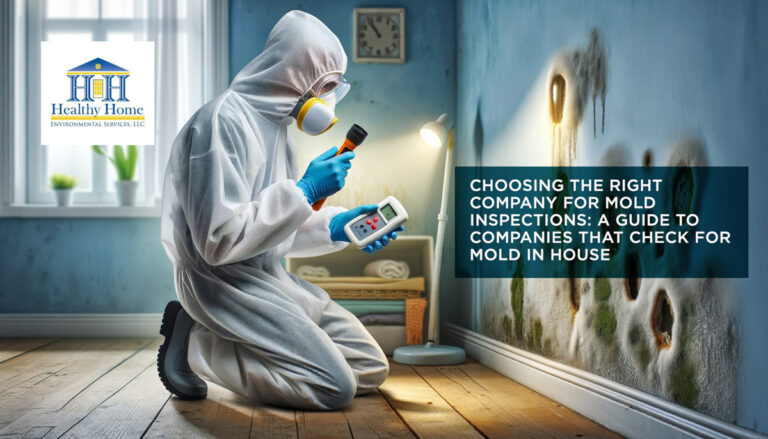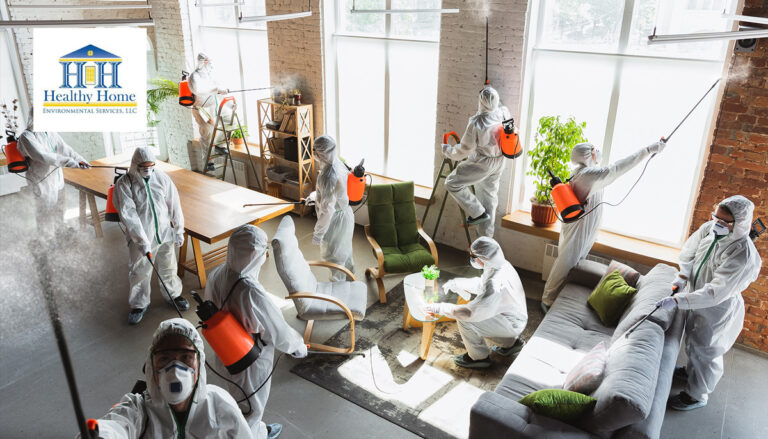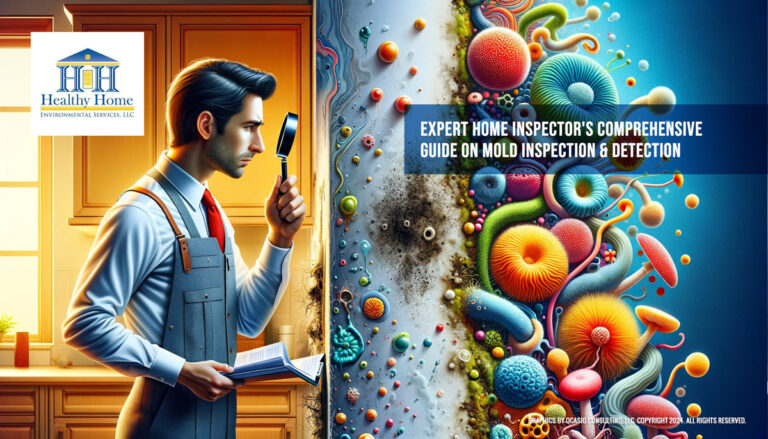Unlocking the Mysteries of Mold: Comprehensive Test and Sampling Strategies
Welcome to Healthy Home Environmental Services, the leading mold and air quality experts in Central Florida. Did you know that according to a study by the Environmental Protection Agency (EPA), approximately 50% of homes in the United States have mold problems? Mold can be a serious issue, impacting both the health of occupants and the structural integrity of the property. That’s why it’s essential to have professional mold testing and sampling strategies in place to ensure a safe and healthy indoor environment.
At Healthy Home Environmental Services, our team, led by Dana and Sally Aiking, specializes in mold home inspections, mold testing, and indoor air quality testing. With our expertise, we can help you identify and address any mold or air quality issues in your home or office. Don’t wait to ensure your space is safe and clean. Call us now at (407) 273-9387 to book your appointment or to find out more!
Key Takeaways:
- Mold is a prevalent issue, impacting approximately 50% of homes in the United States.
- Professional mold testing and sampling strategies are crucial for maintaining a safe and healthy indoor environment.
- Healthy Home Environmental Services specializes in inspections, mold testing, and indoor air quality assessments.
- Contact us at (407) 273-9387 to schedule your appointment or learn more about our services.
- Don’t wait to address mold and indoor air quality issues. Take proactive steps to ensure a safe and clean living environment.
Table of Contents
Introduction to Mold and Air Quality Testing and Sampling
Mold is a common problem that can have serious implications for your health and the structural integrity of your property. It thrives in damp and humid conditions, often going unnoticed until it becomes a larger issue. Mold can release harmful mold spores into the air, which can be detrimental to your respiratory health when inhaled.
Testing for mold and sampling the indoor air is an essential step in identifying and addressing mold issues. By understanding the basics of mold and its detection, you will be better equipped to create a healthier living or working environment.
Why Testing for Mold in Your Central Florida Home is Essential
Testing for mold in your Central Florida home is essential to protect your health and the integrity of your property. Mold can pose significant risks to both your respiratory system and the structural components of your home. By conducting mold tests and identifying the presence of mold particles, you can take proactive measures to address and mitigate any mold-related issues.
The Risks of Mold Exposure in Indoor Environments
Exposure to mold spores can lead to various respiratory problems, including coughing, wheezing, and throat irritation. Prolonged mold exposure can also trigger allergic reactions, such as sneezing, itching, and skin rashes.
For individuals with compromised immune systems or pre-existing respiratory conditions, mold exposure can have more severe health effects. Therefore, it is crucial to identify and address any visible mold growth or signs of water damage that may contribute to mold growth inside your home.
Identifying Hidden Mold Growth Through Professional Inspection
Professional mold inspection is an essential step in detecting hidden mold growth in your home. Trained mold inspectors have the expertise to identify mold in hard-to-reach areas, such as behind walls, under flooring, or in other concealed spaces.
By utilizing specialized equipment, such as moisture meters and thermal imaging cameras, professionals can accurately pinpoint areas with high moisture levels and potential mold growth. Early detection of hidden mold ensures timely remediation, preventing further damage and potential health risks.
Indoor Air Quality and Its Impact on Your Health
The quality of indoor air is directly linked to your overall health and well-being. Mold growth contributes to poor indoor air quality by releasing mold spores into the air. These microscopic particles can then be inhaled, leading to respiratory problems and ongoing health concerns.
In addition to mold, other pollutants, such as dust, pet dander, and VOCs (volatile organic compounds), can contribute to poor indoor air quality. Regular mold testing and air quality assessments help identify potential sources of contamination and enable you to take appropriate measures to improve the air you breathe.
When it comes to the safety and health of your family, don’t underestimate the importance of testing for mold in your Central Florida home. By understanding the risks of mold exposure, identifying hidden mold growth through professional inspection, and considering the impact of indoor air quality on your health, you can create a mold-free and healthy living environment for everyone. Take the necessary steps to address any visible mold growth, presence of mold particles, or suspected mold problem to ensure a safe and comfortable home.
Choosing the Right Mold Test Kit for Accurate Sampling
When it comes to mold testing, choosing the right test kit is essential for accurate sampling and detection. With a wide range of options available, it can be challenging to determine which test kit will provide the most reliable results. In this section, we will explore the different types of mold testing methods, discuss the benefits of professional mold test kits over DIY solutions, and provide guidelines on how to properly collect air samples for mold detection.
Understanding Different Types of Mold Testing Methods
There are various methods available for testing mold, each with its pros and cons. The two primary types of mold testing methods are surface testing and airborne sampling. Surface testing involves collecting samples from visible mold growth or suspected areas of contamination.
This method helps identify the types of mold present on surfaces such as walls, floors, or furniture. Airborne sampling, on the other hand, involves collecting samples of mold spores from the air. This method is used to assess the concentration of mold spores in the indoor environment and determine if there is a mold problem.
The Benefits of Professional Mold Test Kits Over DIY Solutions
While DIY mold test kits are readily available, professional mold test kits offer several advantages. Professional mold test kits are often more accurate and reliable, providing precise results that can help homeowners make informed decisions about mold remediation.
These kits are designed to meet industry standards and are calibrated to ensure accurate sampling and detection of mold. Additionally, professional mold test kits typically come with comprehensive instructions and guidance on how to use them effectively.
How to Properly Collect Air Samples for Mold Detection
To properly collect air samples for mold detection, it is crucial to follow specific guidelines. Here are some essential steps to consider:
- Choose the right mold test kit: Select a mold test kit that is designed for collecting air samples. These kits typically include a calibrated air pump and collection cassettes or petri dishes.
- Identify sampling locations: Determine the areas in your home where you suspect mold growth or where you want to test for the presence of mold spores.
- Prepare the collection equipment: Follow the instructions provided with the mold test kit to properly prepare the air pump and collection cassettes or petri dishes.
- Turn off fans and close windows: Before collecting air samples, ensure that fans and HVAC systems are turned off, and windows and doors are closed to avoid interference from outdoor air.
- Perform the mold air sampling: Follow the specific instructions provided with the mold test kit to collect air samples from the identified locations. Typically, this involves running the air pump for a specified period while the collection cassettes or petri dishes capture the airborne mold spores.
- Seal and label the collection samples: Once the air samples are collected, seal them in the provided containers and label them with the corresponding sampling locations.
- Send the samples to a reputable laboratory: Mail the collected air samples to a reputable laboratory for analysis and interpretation of the results.
By following these guidelines, you can ensure proper collection of air samples for mold detection and obtain accurate results that will help you make informed decisions about mold remediation.
In summary, selecting the right mold test kit is crucial for accurate sampling and detection. Understanding the different types of mold testing methods, the benefits of professional mold test kits over DIY solutions, and how to properly collect air samples for mold detection are essential for obtaining reliable results. By using the appropriate test kit and following proper collection techniques, you can effectively identify mold issues and take the necessary steps to maintain a mold-free and healthy indoor environment.
The Crucial Steps in a Professional Mold Inspection Process
Visual Inspection: The First Line of Defense Against Mold
A visual inspection is the first step in a professional mold inspection process. Certified mold inspectors and mold inspection specialists will thoroughly examine your property for any visible signs of mold growth. This includes checking areas prone to moisture, such as basements, bathrooms, and crawl spaces, as well as inspecting walls, ceilings, floors, and HVAC systems for any signs of water damage or mold infestation. By visually identifying areas of concern, our experts can determine the extent of the mold problem and develop an effective remediation plan.
Assessing Mold Contamination Through Airborne Mold Spores
In addition to the visual inspection, airborne mold spore sampling is crucial in assessing mold contamination levels in your home. This involves collecting air samples from various areas of your property and sending them to a laboratory for analysis. By measuring the concentration of mold spores in the air, we can determine if elevated levels of mold are present, even if there are no visible signs. This helps us identify mold issues that may be hidden behind walls, under carpets, or in other hard-to-reach areas.
Identifying Mold Species: A Key Factor in Effective Remediation
Identifying the specific species of mold present in your home is vital in developing an effective mold remediation plan. Different types of mold require specific treatment methods, and some may pose more significant health risks than others. Our certified mold inspectors and mold inspection specialists have the expertise to accurately identify mold species through in-depth analysis. This knowledge allows us to determine the appropriate remediation techniques and ensure the complete removal of mold from your property.
When it comes to mold inspection services, trust the expertise of our certified mold inspectors and mold inspection specialists. We follow a comprehensive process that includes visual inspection, assessment of airborne mold spores, and identification of mold species. By taking these crucial steps, we provide a thorough and accurate mold assessment, ensuring the safety and health of your home.
Interpreting Your Mold Test Results: What Comes Next?
Once you have conducted a mold test and obtained the results, it’s important to understand what they mean and how to proceed. In this section, we will provide guidance on deciphering test kit readings, specifically focusing on the mold spores count and its significance.
Deciphering Test Kit Readings: Mold Spores Count and Its Significance
The mold spores count in your test results indicates the concentration of mold spores present in the air sample. Typically, the count is measured as the number of spores per cubic meter (spores/m³) of air. This measurement helps determine the extent of mold contamination and the potential health risk it poses.
It’s important to note that the acceptable level of mold spores in indoor environments can vary depending on factors such as the species of mold and the sensitivities of the occupants. Generally, a high mold spores count indicates a higher risk of mold-related health issues, especially for individuals with respiratory conditions or weakened immune systems.
When to Consider Mold Remediation: Understanding Your Test Results
Based on the mold test results, you may need to consider mold remediation to address the issue. Some scenarios that indicate the need for remediation include:
- High mold spores count exceeding acceptable levels
- Persistent moisture problems contributing to mold growth
- Visible mold or mildew growth
- Evidence of water damage or leaks
It’s a good idea to consult with mold removal services or mold inspectors to assess the severity of the mold problem and develop an appropriate remediation plan.
Potential Mold Hotspots in Your Home and Preventive Measures
Understanding the potential mold hotspots in your home can help you take preventive measures to minimize mold growth. Some common areas where mold thrives include:
| Potential Mold Hotspots | Preventive Measures |
|---|---|
| Bathrooms with poor ventilation | Install and use exhaust fans, keep surfaces dry |
| Kitchens with moisture-prone spaces | Fix leaks, use proper ventilation, clean spills promptly |
| Basements and crawl spaces | Control humidity levels, seal cracks, improve drainage |
| Attics with inadequate insulation | Improve insulation, ensure proper ventilation |
By taking preventive measures targeted at these potential mold hotspots, you can significantly reduce the likelihood of mold growth and maintain a healthier living environment.
Combating Mold: Effective Remediation Strategies and Preventative Tips
Mold removal is a crucial step in maintaining a healthy indoor environment. In this section, we will explore various effective mold remediation strategies and provide preventative tips to help you combat mold and create a safer living space.
Professional Mold Remediation vs. Home Remedies: What Works Best?
When it comes to mold removal, you have the option to either hire professional mold remediation services or attempt DIY home remedies. Both options have their pros and cons.
Professional mold remediation offers the expertise of trained specialists who can accurately assess the mold problem, efficiently remove the mold, and ensure thorough cleanup. They have access to calibrated air pumps and can collect indoor air samples to identify the types of mold present, allowing for targeted remediation.
On the other hand, home remedies may be suitable for minor mold issues or as a temporary solution. These remedies often involve using household cleaning agents and improving ventilation to minimize moisture and mold growth. However, it’s important to note that home remedies may not effectively address extensive mold infestations or hidden mold behind walls.
Minimizing Mold Growth: Humidity Control and Proper Ventilation
To prevent mold growth, it’s essential to address the underlying moisture problem in your home. Here are some tips to help you minimize mold growth:
- Maintain good indoor humidity levels below 50% by using dehumidifiers or air conditioners.
- Fix any water leaks or plumbing issues promptly.
- Ensure proper ventilation in bathrooms, kitchens, and other areas prone to moisture accumulation.
- Use exhaust fans or open windows when cooking, showering, or doing laundry.
- Regularly clean and dry surfaces prone to mold growth, such as showers and sinks.
Long-Term Solutions for Mold Prevention and Indoor Air Quality Maintenance
Preventing mold from recurring is crucial for maintaining a healthy indoor environment. Here are some long-term solutions to consider:
- Perform regular mold assessments and inspections to detect and address any potential mold issues.
- Consult professional mold inspectors who can identify the source of mold, assess the presence of mold particles in the air, and recommend appropriate remediation measures.
- Address water damage promptly, whether from leaks, floods, or excessive humidity.
- Use a calibrated air pump to collect indoor air samples and determine the concentration of mold spores present.
- Implement proper mold remediation techniques based on the type of mold identified.
By implementing these strategies and tips, you can effectively combat mold, prevent its recurrence, and maintain optimal indoor air quality.
| Mold Remediation Strategies | Pros | Cons |
|---|---|---|
| Professional mold remediation | Expertise and experience | Higher cost |
| Home remedies | Cost-effective | May not be effective for extensive mold infestations |
Note: The choice between professional mold remediation and home remedies depends on the severity of the mold problem and your budget. For extensive mold infestations or hidden mold, professional services are recommended for thorough removal and remediation.
Tackling Indoor Air Quality: Beyond Mold Testing
Indoor air quality is a crucial aspect of maintaining a safe and healthy home environment. While mold testing is essential, there are other pollutants that can impact your well-being. In this section, we will explore common indoor air pollutants that can be found in Central Florida homes. We will also discuss the importance of regular air quality testing and the role of dehumidifiers and air purifiers in maintaining optimal indoor air.
Addressing Common Indoor Air Pollutants in Central Florida Homes
In addition to mold and mildew, Central Florida homes may be exposed to various indoor air pollutants. These pollutants can range from pet dander and pollen to volatile organic compounds (VOCs) emitted by household products. It is important to address these pollutants as they can contribute to respiratory problems and other health effects. By identifying and mitigating the sources of these pollutants, you can improve the quality of your indoor air.
How Regular Air Quality Testing Can Contribute to a Healthier Home Environment
Regular air quality testing is a proactive approach to ensuring a healthier home environment. By conducting air quality tests, you can detect the presence of pollutants that may not be visible to the naked eye.
Testing can help you identify areas or activities that contribute to poor air quality, allowing you to take necessary measures to improve ventilation, eliminate sources of pollution, or implement filtration systems.
With the assistance of an air quality testing company, you can gain valuable insights into the quality of your indoor air and make informed decisions about improving it.
The Role of Dehumidifiers and Air Purifiers in Maintaining Optimal Indoor Air
Dehumidifiers and air purifiers play a vital role in maintaining optimal indoor air quality. A dehumidifier helps to control moisture levels, preventing the growth of mold and mildew. It reduces musty odors and helps protect building materials from damage caused by excess moisture.
On the other hand, air purifiers filter out airborne contaminants, such as allergens and particles, improving the overall air quality. By utilizing these tools, you can create a cleaner and healthier living space for you and your family.
Conclusion
Mold testing and sampling are crucial components in maintaining a safe and healthy indoor environment. Throughout this article, we have emphasized the importance of indoor environmental testing and remediation, focusing on addressing mold problems promptly to mitigate their detrimental effects.
By implementing the strategies and recommendations provided in this guide, you can effectively test for mold, prevent its growth, or undertake mold removal to ensure a mold-free living environment.
Remember that mold problems can lead to various health effects and are often accompanied by musty odors. Surface testing is a key method for identifying the types of mold present, while also enabling you to assess exposure to mold spores. Whether you want to test for mold, prevent mold growth, or perform mold removal, we are here to assist you.
Contact Healthy Home Environmental Services today at (407) 273-9387 to schedule your professional mold and air quality testing services in Central Florida. Our experienced team is ready to help you ensure a mold-free and healthy living environment.








